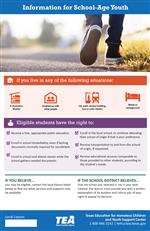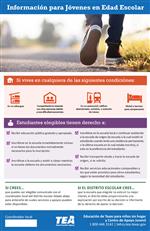- Bastrop Independent School District
- Federal and State Programs
- McKinney-Vento Homeless Assistance Act
Federal & State Programs
Page Navigation
McKinney-Vento Homeless Assistance Act
-
Who are Homeless Children and Youth?
Before schools can be certain they are complying with legislation related to educating students experiencing homelessness, they must understand who can be considered homeless. The McKinney-Vento Act (Sec. 725) defines "homeless children and youths' (school-aged and younger) as:
- Children and youths who lack a fixed, regular, and adequate nighttime residence, including children and youths who are:
- Sharing the housing of other persons temporarily due to loss of housing, economic hardship, or a similar reason.
- Living in motels, hotels, trailer parks, or camping grounds due to lack of alternative adequate accommodations
- Living in emergency or transitional shelters.
- Abandoned in hospitals
- Awaiting foster care placement.
- Children and youths who have a primary nighttime residence that is a public or private place not designed for, or ordinarily used as, regular sleeping accommodations.
- Children and youths who are living in cares, parks, public spaces, abandoned buildings, substandard housing, bus or train stations, or similar settings
- Migratory children who qualify as homeless because they are living in the circumstances described above
- The term unaccompanied youth includes a youth, not in the physical custody of a parent or guardian. This would include runaways living in runaway shelters, abandoned buildings, cars, on the streets, or in other inadequate housing; children and youths denied housing by their families (sometimes referred to "throwaway children and youths"); and school-age unwed mothers living in homes for unwed mothers because they have no other housing available.
Student Residency Questionnaire - English
Student Residency Questionnaire - Español
Welcome Kit - English / Español
Unaccompanied Youth
-
These are youth not in the physical custody of a parent or guardian. This would include youth living in runaway shelters, abandoned buildings, cars, on the streets, or in other inadequate housing and children and youth denied housing by their families (sometimes referred to as "throwaway" children and youth), and school-age unwed mothers, living in homes for unwed mothers, who have no other housing available.
In determining whether or not a child or youth is homeless, consider the relative permanence of the living arrangements. Determination of homelessness should be made on a case-by-case basis.
TIPS FOR EDUCATORS AND SCHOOL STAFF
-
- Identification Tool for School Staff - Sample Identification tool that will provide increased awareness of possible indicators and risk factors of students and families experiencing homelessness.
- Homeless Students in Texas Public Schools
- TEHCY Directory of Homeless Liaisons
- Supporting the Success of Homeless Children and Youth
- FAQ Education Rights and amendments by ESSA
The McKinney-Vento Homeless Assistance Act
-
The education provisions of the McKinney-Vento Act, which are now incorporated within Every Student Succeeds Act (ESSA) to ensure educational rights and protections for children and youth experiencing homelessness. The law directly applies to homeless unaccompanied youth who also receive some special attention within the Act.
The Act’s Key Provisions
The McKinney-Vento Act (Section 725) specifies and protects the rights of children and youth in homeless situations. Highlights include:
Immediate Enrollment – The right to be enrolled immediately in school, without immunization or academic records, and birth certificate, regardless of district policy.
Transportation – Students in highly mobile or homeless situations are entitled to transportation to and from the school of origin, if it is feasible, in the student’s best interest, and requested by the parent, guardian, or unaccompanied youth.
Services – Students experiencing homelessness are entitled to the same programs and services that are available to other children in the District, such as gifted and talented education, special education, vocational education, English Language Learner services, and tutoring. Students are automatically eligible for Title I services and Districts must set aside funds as necessary to provide services.
Homeless Student School Choice
Students who are experiencing homelessness have the right to attend school in their school of origin or in the school in the attendance area where the family or youth is currently residing. School of origin is defined as the school in which the child/youth was enrolled when they became homeless or the school in which the child/youth was last enrolled. The campus a child attends is determined by which campus can serve the best interests of the child. In Texas, a student experiencing homelessness may enroll in any district they choose, regardless of the location of their residence, school of origin or attendance zone campus.
Dispute Resolution – If problems arise between the school and parents or between districts, the parent shall be referred to the school’s homeless liaison. In the meantime, the student must remain in school and receive transportation.
-
Nataly Sanchez
- McKinney-Vento & MEP Services Coordinator
- 512-772-7151
- nsanchez@bisdtx.org
-
Frequently Asked Questions
-
How is homeless defined under McKinney-Vento?
Under the McKinney-Vento Act, the term “homeless children and youths” means individuals who lack a fixed, regular, and adequate nighttime residence.
-
What living situation is considered homeless under McKinney-Vento?
Homeless children and youth who are:
- sharing the housing of others due to loss of housing or economic hardship
- living in motels, hotels, trailer parks, or camping grounds
- living in emergency or transitional shelters
- living in cars, parks, public spaces, abandoned buildings, or substandard housing.
-
What are the student rights under McKinney-Vento?
- Receive a free, appropriate public education
- Enroll in school immediately even if lacking documents normally required for enrollment
- Enroll in school and attend classes while the school gathers important documents
- Enroll in the local school or continue attending their school of origin, if preferred
- Receive transportation to and from school of origin, if requested
- Receive educational services comparable to those provided to other children, according to your children’s needs
-
How are students and families identified within our district?
Students are identified via online school registation or verification process according to their living situation or circumstances. The Student Services department staff identify families and assess to determine eligibility on a case by case basis.
-
Who are the designated staff on campuses providing services to students/families through the PATHS Project?
Campus Support Staff are located on each Bastrop ISD campus and work in collaboration with Student Services staff and other departments to provide support/services as needed.
-
How long are students and families eligible to receive services?
Once it is determined that a student/family meets the homeless definition under McKinney-Vento families are eligible to receive services through the PATHS Projects. Students/families remain eligible for the remainder of the year and eligibility is re-assessed every year to continue participation in the program.
-
How can students and families be referred for homeless assistance?





